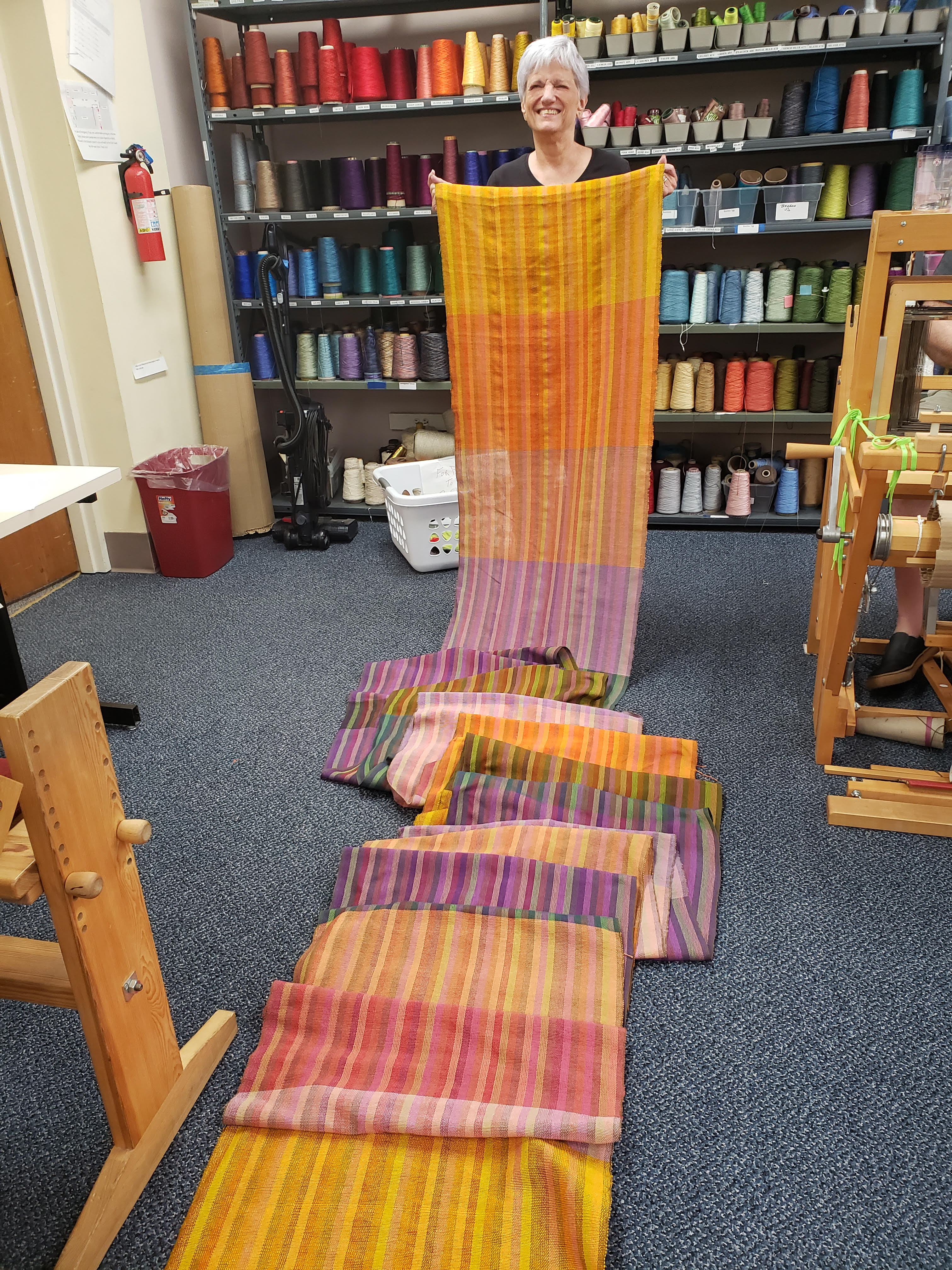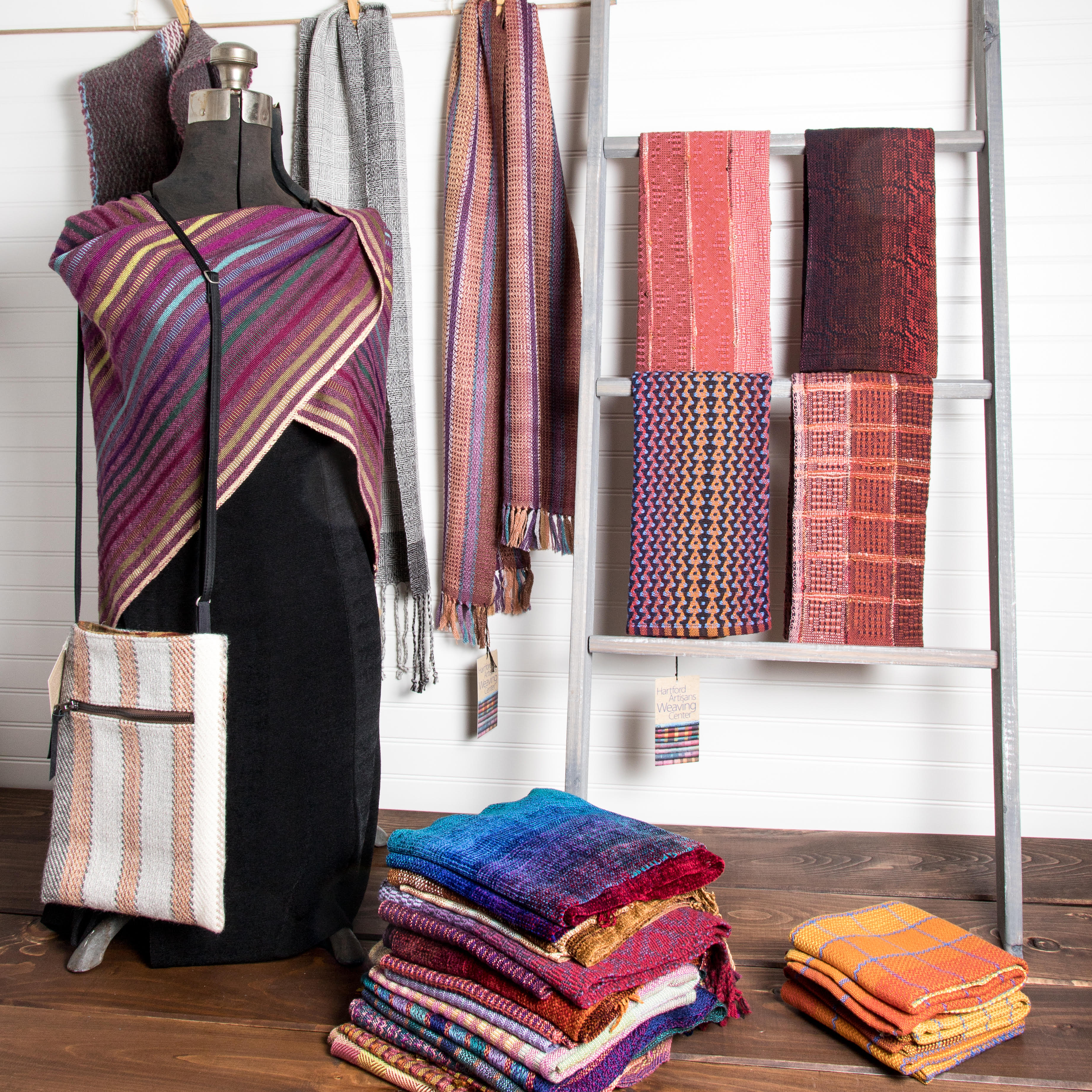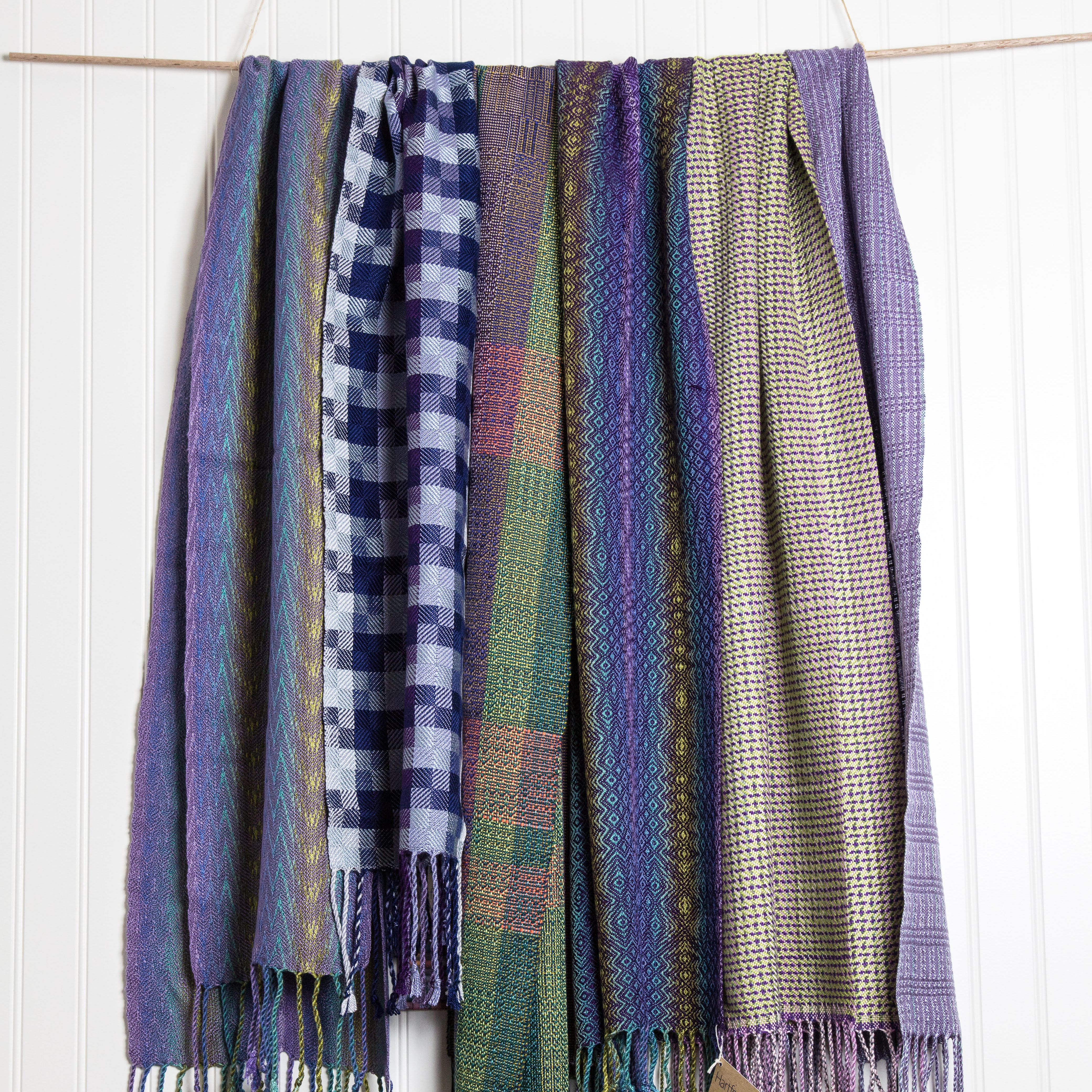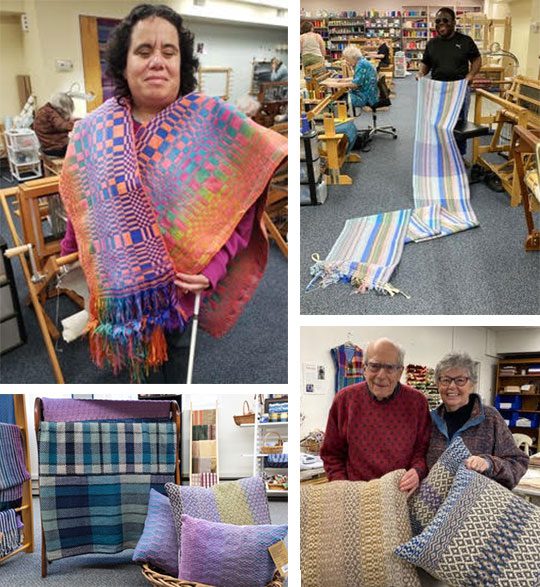
Artisans spend months mastering the craft before creating textiles for the Center’s shop.
The Hartford Artisans Weaving Center (HAWC) is tucked away on a side street in Connecticut’s capital city, surrounded by law firms and apartment buildings. It’s easy to miss, but once inside you’ll find a hive of creativity, skill and productivity.
Like most weaving centers across the country, HAWC offers weaving classes and workshops to the general public, holds an annual sales event, and promotes the craft of weaving through frequent demonstrations and pop-up displays. What sets them apart from the rest and helps them fulfill their mission to enrich lives through hand-weaving, is their unique and aptly named Artisan Program.
More than a Hobby
The Artisan Program teaches people who are blind, visually-impaired, or anyone 55 and older to weave. But learning to weave is just the first step. If accepted into the program, an Artisan spends about six months mastering the craft, then they commit to being in the studio at least once a week where they’ll produce the woven fabric that is then used to make the products sold in the Center’s on-site shop and website. Incredibly, most of the Artisans have no prior weaving experience. Many have been referred to the Center by doctors, community groups, and other Artisans who know about the Center’s unique program. Their only requirement is that they must be open to a long-term commitment to weave at the Center.
For their time and commitment, the Artisans receive a well-earned stipend. It’s important to HAWC to keep their Artisan retention rate high; in fact, eight of the Artisans have been with the program since its inception in 2009. There are currently 30 active Artisans at HAWC who weave anywhere from once a week to four days a week.
Highlighting the Artisans’ sense of belonging and empowerment, one of the long-time Artisans, Carmen, says,
“I lost my vision due to glaucoma over 25 years ago. I enjoy the work here. When I weave here at the Center, I don’t feel like I’m blind. It makes me feel like nothing is impossible.”
Make no mistake – the work produced by the Artisans is top notch. One look around the shop and you’ll see that the quality rivals any high-end boutique or gift shop. The hottest sellers by far are scarves made of silk, bamboo, cotton and wool, followed closely by kitchen towels made of sturdy, absorbent cotton. The Center, open Monday through Thursday, is in essence a small textile workshop, producing beautifully designed pieces all woven by hand. Custom orders are welcome as well; some recent requests include shawls for a bridal party and table linens in custom colors and sizes.
“We’re like a tiny, micro-enterprise, reliant on everybody doing their part,” says Ann Kollegger, HAWC’s Executive Director. She adds, “We’re set up like a relay where the projects are passed through our team of weaving volunteers, Artisans and finally sewing volunteers. Many hands touch our products and the process works extraordinarily well.”
Artisans with visual impairment, including those who have totally lost their sight, and people over the age of 55 practice this daunting skill of hand weaving in a community of likeminded individuals who love the craft.
Early Years
HAWC originated as the Hartford Artisans’ Center at the former Oak Hill School for the Blind, created by Dr. Rebecca Earl and Edjohnetta Miller in 1995. In 2009, after the weaving program was closed unexpectedly, the studio manager, Fran Curran, recruited two of the center’s fervent volunteers to help her open a stand-alone weaving center that would continue to focus on serving the blind and the older population. Her vision and inspiration to keep the program going was a great success and has been a haven for textile lovers – both makers and buyers – ever since. The trio that founded the reimagined HAWC, Fran Curran, Dorrie Hunt, and Claudia Spaulding, are still active at the Center and are members of the Board of Directors.
The Center currently employs four staff members.
Operations
Studio Space
HAWC has two main weaving studios that are set up as supportive and welcoming spaces, with staff and volunteers close at hand to assist the Artisans. The Center’s shop and a fully outfitted sewing room are right next to the studios. Classroom space is on the lower level along with a room to store the Center’s hundreds of cones of yarn. Another room on the lower level is overflowing with weaving ephemera and antique and older-model looms available for sale. An additional classroom location was opened in 2017 in Manchester, CT, a suburb about 10 miles east of Hartford. Evening classes and workshops are held in the Manchester studio which is housed, coincidentally, in an old weaving mill.


Finished handwoven scarves on display in the Center’s on-site shop.
Volunteers
To make this unique operating model work, dozens of volunteers (currently 58!) help keep the looms humming along by doing the intricate and sometimes tedious work of prepping the yarn and threading each strand onto the loom according to the pattern. Skilled volunteers also staff the sewing and finishing room where they iron, fringe, and sew the finished cloth into everything from clothing and table runners, to hand towels and baby blankets. On a typical day, four volunteers work in the weaving studio and two in the sewing room.
Funding
The nonprofit’s income comes from multiple sources, including merchandise sales, tuition from weaving classes, and the generous support of individual donors and state grants. (HAWC’s How to Dress a Floor Loom YouTube video, featuring the Center’s Studio Manager Sally Mullen, has 56,000 views!)
HAWC in the Community
Being involved in the local community is an important part of the HAWC’s vision. They pack up suitcases and hit the road to display the Artisans’ wares at holiday pop-ups, museums, libraries and festivals. Organizations they work closely with include the Hill-Stead Museum, the New England Fiber Fest and the Handweaver’s Guild of Connecticut.
Each November, the Center is transformed into a beautifully curated retail space open to the public, featuring the handiwork of the Artisans over the past year. There are floor-to-ceiling shelving displays for throw pillows and tote bags, racks and racks of scarves, and tables set with runners, placemats and cloth napkins, to name just a few. Volunteers staff the sale while Artisans demonstrate weaving techniques to interested visitors. The celebratory atmosphere adds to the creative and fun vibe – and helps generate donations from patrons, always key for nonprofits.
In addition to their commitment to the art of weaving, the Center is committed to important social issues, as summed up in one of their guiding principles: We recognize we have a responsibility not only to open our doors wider, but also to understand and work to change the racial, gender, social and cultural inequalities that hurt us all.

Artisans showcase the beautiful pieces they’ve created.
A Third Space
In an era where third spaces – community-based hubs other than home or the workplace – are desperately needed to combat isolation and loneliness, HAWC is a haven for the Artisans and volunteers. There’s always a pot of coffee brewing in the break room and home-baked snacks laid out for the taking. One of the Artisans, Pam, reflects,
“The Weaving Center is a wonderful combination of community, collaboration and creativity and a place to indulge my love of fiber and color.”
The Center’s vision is to be widely known as a bustling and thriving community hub – by the looks of the Center today, they’ve no doubt strengthened the fabric of the Hartford community.
The Hartford Artisan Weaving Center is at 42 Woodland St. in Hartford, CT. Shop hours are Monday – Thursday 10:00 – 4:00pm and Friday 10:00 to 2:00pm. To learn more, or to shop HAWC’s selection of products, visit their website at weavingcenter.org

Paula Wilson
contributor
Paula is a freelance writer and editor with a background in marketing and communications. She is a lifelong maker who especially loves to crochet and quilt. Her latest craft endeavor is learning how to weave on a floor loom. Paula has been published in the New York Times and has written 10 children’s nonfiction books. She lives in Glastonbury, Connecticut.

Thanks for the tip on where to shop for holiday gifts this year!